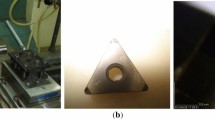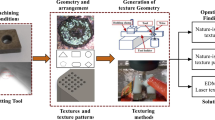Abstract
The life of a tool is affected by many factors such as cutting speed, depth of cut, chip thickness, tool geometry, workpiece material, cutting fluid and the rigidity of the machine tool. This paper introduces the innovative turning strategy of variable feed turning. The workpiece material was AISI 1050, and two types of TiN-coated insert (CNMG-120408 (NC3020) and DNMG 150608-NM4 WPP20) were used as cutting tools in the machining tests. A thorough investigation was carried out on the effect on tool life of a gradual feed rate at a constant depth of cut and cutting speed with no cooling fluid. The feed rate was gradually increased twice every millimetre at the beginning of turning and kept constant for the rest of the cut. Turning experiments were conducted with both constant and variable feed rates. Brand new inserts were deployed in the experiments related with constant feed rate for each time period. Comparisons showed the significant influence of the variable feed rate. Apart from the reduction in initial wear, the new turning strategy produced very positive results regarding tool wear in the moderate wear zone, and a considerable increase of 32 % in tool life was achieved. Moreover, with the new strategy, total tool life was prolonged by up to 35 %.
Similar content being viewed by others
References
Xavior MA, Adithan M (2009) Determining the influence of cutting fluids on tool wear and surface roughness during turning of ASSI 304 austenitic stainless steel. J Mater Process Technol 209(2):900–909
Kophac J (1998) Influence of cutting material and coating on tool quality and tool life. J Mater Process Technol 78(1–3):95–103
Dahu Z, Xiaoming Z, Han D (2013) Tool wear characteristics in machining of nickel-based superalloys. Int J Mach Tools Manuf 64:60–77
Jianwen H, Chou KY (2007) Characterizations of cutting tool flank wear-land contact. Wear 263:1454–1458
Merhban M, Naderi D, Panahizadeh V, Naeini HM (2008) Modelling of tool life in turning process using experimental method. Int J Metal Forming 1:559–562
Grzymkowski M, Kapinski S (1976) Friction and lubrication in the processes of sheet forming. Mechanik 2:69–72
Janecki J, Hebda M (1969) Friction, lubrication and wear of machine parts. WNT, Warsaw
Hyrniewicz T, Pluta Z (2012) Novel modeling of tool edge wear. Tribol Trans 55:230–236
Sadik MI, Bo L (1993) The role of tool-chip contact length in metal cutting. J Mater Process Technol 37:613–627
Sadik MI, Bo L (1993) The effect of restricted contact length on tool performance. J Mater Process Technol 48:275–282
Sutter G (2005) Chip geometries during high-speed machining for orthogonal cutting conditions. Int J Mach Tools Manuf 45:719–726
Iqbal SA, Mativenga PT, Sheikh MA (2007) Characterization of the machining of AISI 1045 steel over a wide range of cutting speeds- part 1: investigation of contact phenomena. Proc IMechE B J Eng Manuf 221(5):909–916
Toropov A, Ko SL (2003) Prediction of tool chip contact length using a new slip-line solution for orthogonal cutting. Int J Mach Tools Manuf 43:1209–1215
Zadshakoyan M, Pourmostaghimi V (2013) Genetic equation for the prediction of tool–chip contact length in orthogonal cutting. Eng Appl Artif Intell 26(7):1725–1730
Bahi S, Nouari M, Moufki A, ElMansori M, Molinari A (2011) A new friction law for sticking and sliding contacts in machining. Int J Tribol 44:764–771
Oral A, Cakir MC, Gonen D, Karaoglan AD (2014) Investigating the effects of variable feed rate on tool life in turning. The 16th International Conference on Machine Design and Production, Izmir, June 30 – July 03 2014
Klim Z, Ennajimi E, Balazinski M, Fortin C (1996) Cutting tool reliability analysis for variable feed milling of 17-4PH stainless steel. Wear 195:206–213
Sikdar SK, Chen M (2002) Relationship between tool flank wear area and component forces in single point turning. J Mater Process Technol 128:210–215
Yuefeng Y, Wuyi C, Liansheng G (2010) Tool materials rapid selection based on initial wear. Chin J Aeronaut 23:386–392
Taylor FW (1907) On the art of metal cutting. Trans ASME 28:31–35
Woldman NE, Gibbons RC (1951) Machinability and machining of metals. McGraw-Hill, New York, pp 47–53
Balazinski M, Mpako C (2000) Improvement of tool life through the use of two discrete feed rates during machining of 4140 steel. Mach Sci Technol: Int J 4(1):1–13
Balazinski M, Songmene V (1995) Improvement of tool life through variable feed milling of Inconel 600. Ann CIRP 44(1):55–58
Modern Metal Cutting (1994) A practical handbook. Sweden, Sandvik Coromant
Thamizhmanii S, Hasan S (2010) Relationship between flank wear and cutting force on the machining of hard martensitic stainless steel by super hard tools, vol III. Proceedings of the World Congress on Engineering, London, pp 2185–2190, June 30 - July 2
Author information
Authors and Affiliations
Corresponding author
Rights and permissions
About this article
Cite this article
Oral, A., Cakir, M.C., Gonen, D. et al. Experimental investigation of a novel machining strategy for rough turning using variable feed rate. Int J Adv Manuf Technol 87, 779–787 (2016). https://doi.org/10.1007/s00170-016-8521-8
Received:
Accepted:
Published:
Issue Date:
DOI: https://doi.org/10.1007/s00170-016-8521-8




